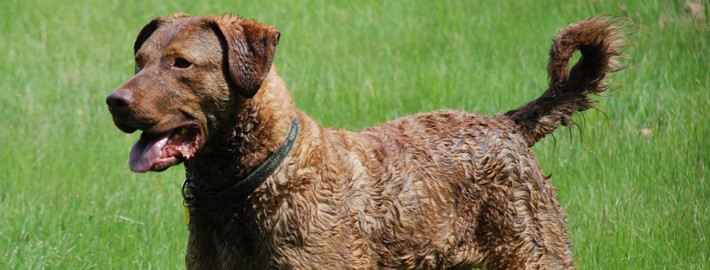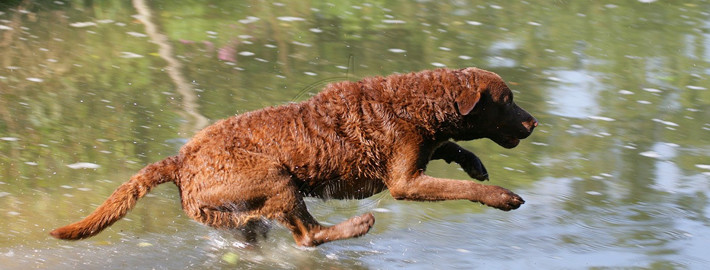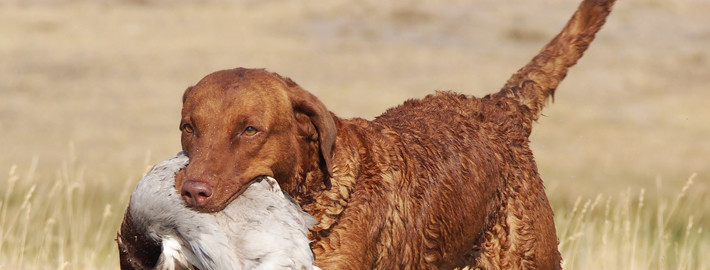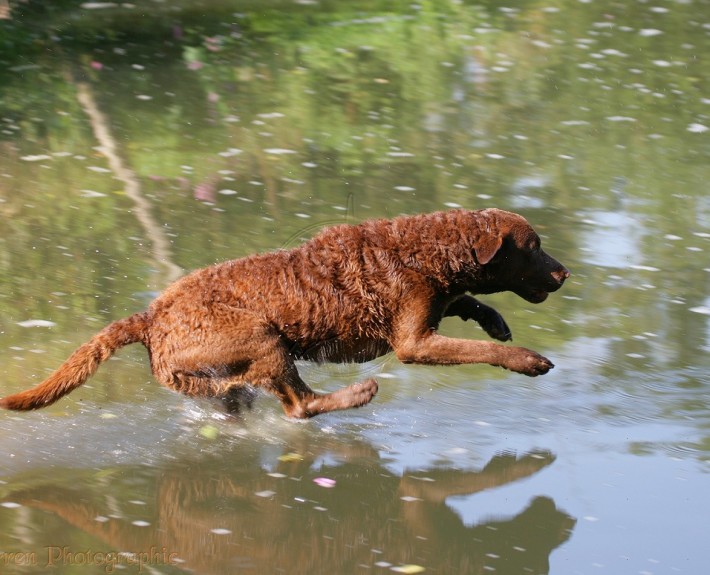What makes the Chesapeake Bay Retriever Unique?
The Chesapeake Bay retriever was developed to hunt waterfowl under adverse conditions, facing strong tides in rough water, high winds and sometimes even having to break through ice. It is an extraordinary swimmer, with a strong, yet tender, bite enabling it to carry birds. It has powerful limbs and webbed feet. The Chessie is slightly longer than tall, with its hindquarters as high, or higher, than its forequarters. Its coat is rendered virtually waterproof by virtue of its oily, harsh outer coat and dense wooly undercoat. The color matches its working surroundings: any shade of brown, sedge or dead grass. The Chesapeake Bay retriever is hardy enough to not only withstand, but also relish, repeated plunges into icy water. It loves to swim and retrieve. Despite an active life when outdoors, inside it tends to be calm. The Chessie tends to be independent, although it is eager to learn. It is reserved with strangers and can be protective; it also can be aggressive toward strange dogs if challenged. This is the hardiest, most strong-willed and protective of the retriever breeds.
Breed Groups
Page Contents

SnapShot
| Size: | Males – 58 to 66 cm (23 to 26 inches) Females – 53 to 61 cm (21 to 24 inches) |
| Weight: | Males – 29 to 36 kg (65 to 80 pounds) Females – 25 to 32 kg (55 to 70 pounds) |
| Origin: | United States of America |
| Life Span: | 10 – 12 Years |
| Colour: | Dark Brown, Deadgrass, Light Brown, Sedge, Brown, Tan |
| Litter Size: | 4 to 6 puppies |
Is the Chesapeake Bay Retriever Right For You?
The Chesapeake Bay retriever was developed to hunt waterfowl under adverse conditions, facing strong tides in rough water, high winds and sometimes even having to break through ice. It is an extraordinary swimmer, with a strong, yet tender, bite enabling it to carry birds. It has powerful limbs and webbed feet. The Chessie tends to be independent, although it is eager to learn. It is reserved with strangers and can be protective; it also can be aggressive toward strange dogs if challenged.
In 5 Words
- Protective
- Quiet
- Happy
- Intelligent
- Affectionate
Characteristics
Learn About the Chesapeake Bay Retriever
Description
The Chesapeake Bay Retriever is a powerful, muscular dog. The head is broad with a medium stop. The muzzle is about the same length as the skull, tapering but not to a point. The wide-set eyes are yellowish to amber in color. The small ears are high set, hanging loosely. The teeth meet in a scissors or level bite. The lips are thin. The tail is medium in length, heavy at the base.
The Chesapeake is a strong, muscular dog with a short, thick wavy coat. He comes in any shade of brown and has yellow or amber coloured eyes. Compared to the Labrador, he is slightly bigger in stature, and has a very different personality.
In body, the Chesapeake is a strong, well-balanced, powerfully built animal of moderate size and medium length in body and leg, deep and wide in chest, the shoulders built with full liberty of movement, and with no tendency to weakness in any feature, particularly the rear. The power though, should not be at the expense of agility or stamina. Size and substance should not be excessive as this is a working retriever of an active nature.
.
Short History of the Chesapeake Bay Retriever
In 1807, an English brig shipwrecked off the coast of Maryland and two Newfoundlands were rescued from the cargo. When bred to local retrievers, including the English Otter Hound, Flat-Coat and Curly-Coated Retriever, the “Chessie” type developed. Bred to work on land and water, the Chesapeake Bay Retriever originally hunted waterfowl in rough and icy waters, often retrieving several hundred birds per day. Members of the breed may also be referred to as a Chessie, CBR, or Chesapeake. The breed was developed in the United States Chesapeake Bay area during the 19th century. Historically used by area market hunters to retrieve waterfowl, it is primarily a family pet and hunting companion.
Temperament
The Chesapeake Bay Retriever should show a bright and happy disposition with an intelligent expression. Courage, willingness to work, alertness, nose, intelligence, love of water, general quality and, most of all, disposition should be given primary consideration in the selection and breeding of the Chesapeake Bay Retriever.
The Chesapeake Bay retriever is hardy enough to not only withstand, but also relish, repeated plunges into icy water. It loves to swim and retrieve.
These are intelligent, brave and obedient dogs. They are trainable, willing and able to please, although they may be a little slow to learn. Chesapeake Bay Retrievers are affectionate, loving, friendly and good with children. They have a passion for water, swimming and retrieving.
Caring for Your Chesapeake Bay Retriever
Grooming & Bathing
He is NOT suitable as a pet dog treated as an equal. If he admires you then he will work for you and love you as only a dog can. Whilst he can be a devoted housedog, it is best combined with an active lifestyle or a working life where both his brain and body are exercised. He craves company and should not be in a home where he is left alone for much of the day.
The oily coat helps protect the dog from icy waters. This breed is an average shedder.
Exercise & Training
The Chessie is a large active dog that needs a daily chance to exercise. It enjoys a good walk or swim. It can live outside in temperate conditions, but more than anything it prefers to spend time with its family.












